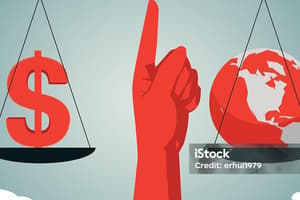Podcast
Questions and Answers
The majority of the world's population owns three quarters of Earth's wealth.
The majority of the world's population owns three quarters of Earth's wealth.
False (B)
What are some problems associated with the products we consume?
What are some problems associated with the products we consume?
The products we consume can be produced in conditions that are detrimental to the environment and to the health of the workers who make them. The workers who produce our goods can be underpaid, and their jobs can even make them suffer slavery-like conditions. Child labor is also used in some parts of the world.
The world will not become a better place if we do not change it ourselves.
The world will not become a better place if we do not change it ourselves.
True (A)
What is the main point of the text?
What is the main point of the text?
What are some factors that contribute to the low levels of development in certain nations?
What are some factors that contribute to the low levels of development in certain nations?
What is Gross Domestic Product (GDP)?
What is Gross Domestic Product (GDP)?
What is the purpose of GDP per capita?
What is the purpose of GDP per capita?
What are two other metrics used to study the level of a nation's development, aside from GDP?
What are two other metrics used to study the level of a nation's development, aside from GDP?
The Human Development Index (HDI) is a metric that considers only a single indicator of development.
The Human Development Index (HDI) is a metric that considers only a single indicator of development.
How can we improve the world? What are some steps individuals can take?
How can we improve the world? What are some steps individuals can take?
The text argues that the news often focuses on positive events and occurrences.
The text argues that the news often focuses on positive events and occurrences.
The world is becoming a worse place, according to the text.
The world is becoming a worse place, according to the text.
What is the definition of "absolute poverty" as defined in the text?
What is the definition of "absolute poverty" as defined in the text?
The rate of illiterate people is increasing worldwide.
The rate of illiterate people is increasing worldwide.
Agricultural production has become less efficient in recent years.
Agricultural production has become less efficient in recent years.
What major problem prevents the world from being able to feed its entire population?
What major problem prevents the world from being able to feed its entire population?
What are some of the ongoing global issues that need attention?
What are some of the ongoing global issues that need attention?
Flashcards
Global Wealth Inequality
Global Wealth Inequality
A significant disparity in the distribution of wealth across the world's population, with a small portion holding a large majority of the assets.
Consumption Impact
Consumption Impact
Our consumption choices have far-reaching consequences for the environment, workers, and the world.
Global Poverty
Global Poverty
A significant portion of the world's population lives in extreme poverty, facing hardships in health care, education, food security, and safety.
Uneven Birth Opportunities
Uneven Birth Opportunities
Signup and view all the flashcards
Responsible Consumption
Responsible Consumption
Signup and view all the flashcards
Circular Economy
Circular Economy
Signup and view all the flashcards
Absolute Poverty
Absolute Poverty
Signup and view all the flashcards
Infant Mortality
Infant Mortality
Signup and view all the flashcards
Fair Trade
Fair Trade
Signup and view all the flashcards
Environmental Problems
Environmental Problems
Signup and view all the flashcards
Political Action
Political Action
Signup and view all the flashcards
Uneven Development
Uneven Development
Signup and view all the flashcards
Study Notes
Global Inequality
- Developed nations (e.g., Europe) possess a disproportionate share of wealth, while the majority of the global population is significantly poorer.
- The wealthiest quarter owns three-quarters of global wealth, whereas the poorest quarter possesses only two percent.
- This disparity is stark when considering the standard of living in developed countries.
Factors Impacting Global Wealth
- Consumption patterns significantly impact global issues.
- Products often have hidden environmental and labor costs (e.g., child labor, harmful conditions).
- Production processes may involve unethical labor practices and unsustainable environmental impact.
- Transportation and production distances can negatively affect the environmental footprint of products and impact resource depletion.
- Food production also has a substantial environmental footprint, especially for animal-based products.
Uneven Distribution of Wealth
- Birth location heavily influences resource access and quality of life.
- Access to quality healthcare, education, and nutrition varies drastically between regions.
- Regions with high infant and childhood mortality rates face significant societal challenges.
Measuring Development
- Nations can be categorized as developed or undeveloped based on different factors.
- Key indicators include GDP per capita, HDI (Human Development Index), infant mortality rate, literacy rates, GINI Index, etc.
- GDP per capita (e.g. US, Qatar, Sweden, Finland, Ethiopia, Burundi)
- GDP is not always an accurate representation of wealth distribution.
- HDI incorporates multiple factors to provide a more holistic picture of a nation's development.
Improving the World
- Individuals can make a positive impact by making responsible consumption choices.
- Consumers can impact issues like transportation, energy consumption, local food choices, Fair Trade products, and consumerism.
- Acknowledging and promoting the circular economy can help reduce resource consumption and waste production.
Studying That Suits You
Use AI to generate personalized quizzes and flashcards to suit your learning preferences.




